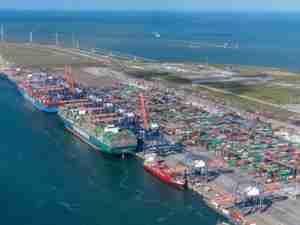Reduced maritime trade with China together with unresolved labor talks have led to a significant decline in West Coast port volumes, which reached their lowest observed point as a percent of total U.S. volume at Fitch-tracked ports based on data from the last 12 years, Fitch Ratings says. Total U.S. port TEUs were down 10% in 4Q22 from 4Q21, with West Coast ports falling 17% yoy versus a 3% decline at East and Gulf Coast ports.
U.S. cargo volume appears to be normalizing after above average increases in 2020 and 2021 as businesses built up inventories in response to robust goods demand. Port volumes generally track the trend in GDP growth, and Fitch expects 2023 U.S. GDP growth to slow to 1.0% compared with 2.1% in 2022. Goods consumption remains strong, but we expect monetary tightening will pressure demand and investment, leading to a mild recession in 3Q23.
Port of Long Beach’s (POLB; AA/AA-/Stable) TEUs in January 2023 declined 28.4% from a year prior, while Port of Los Angeles’ (POLA; AA/Stable) TEUs declined 16.1%. Nevertheless, POLA’s and POLB’s ability to handle larger ships, their sizable local market share and strong representation across shipping alliances support their ability to sustain strong market positions.
The Pacific Maritime Association and International Longshore and Warehouse Union (ILWU) recently resumed contract talks, the outcome of which will affect 29 West Coast ports. Past contract stalemates led to work stoppages that required federal intervention to restart cargo flows. While both sides say they are seeking to avoid stoppages or lockouts, shippers are seeking to diversify their points of entry to avoid any potential disruption given the lack of an agreement. It remains to be seen if there will be a turnaround in volumes back to West Coast ports with the resolution of talks, the timing of which is also unclear.
Throughput at both POLA and POLB, the San Pedro Bay ports, is largely dependent on East Asian imports. Fitch projected Chinese port throughput would worsen with the lifting of Covid restrictions before easing in February. China’s total cargo throughput was up 3% yoy in 4Q22 while foreign trade cargo declined by 1% yoy at eight major Chinese coastal ports, mainly due to continued weakening overseas demand. Longer term, onshoring and near-shoring may reduce U.S.-China trade volumes, although relocating supply chain suppliers will take some time.
Fitch: U.S. ports largely shielded from rising labor costs as cargo volumes normalize
posted by AJOT | Mar 23 2023 at 01:41 PM | Ports & Terminals










